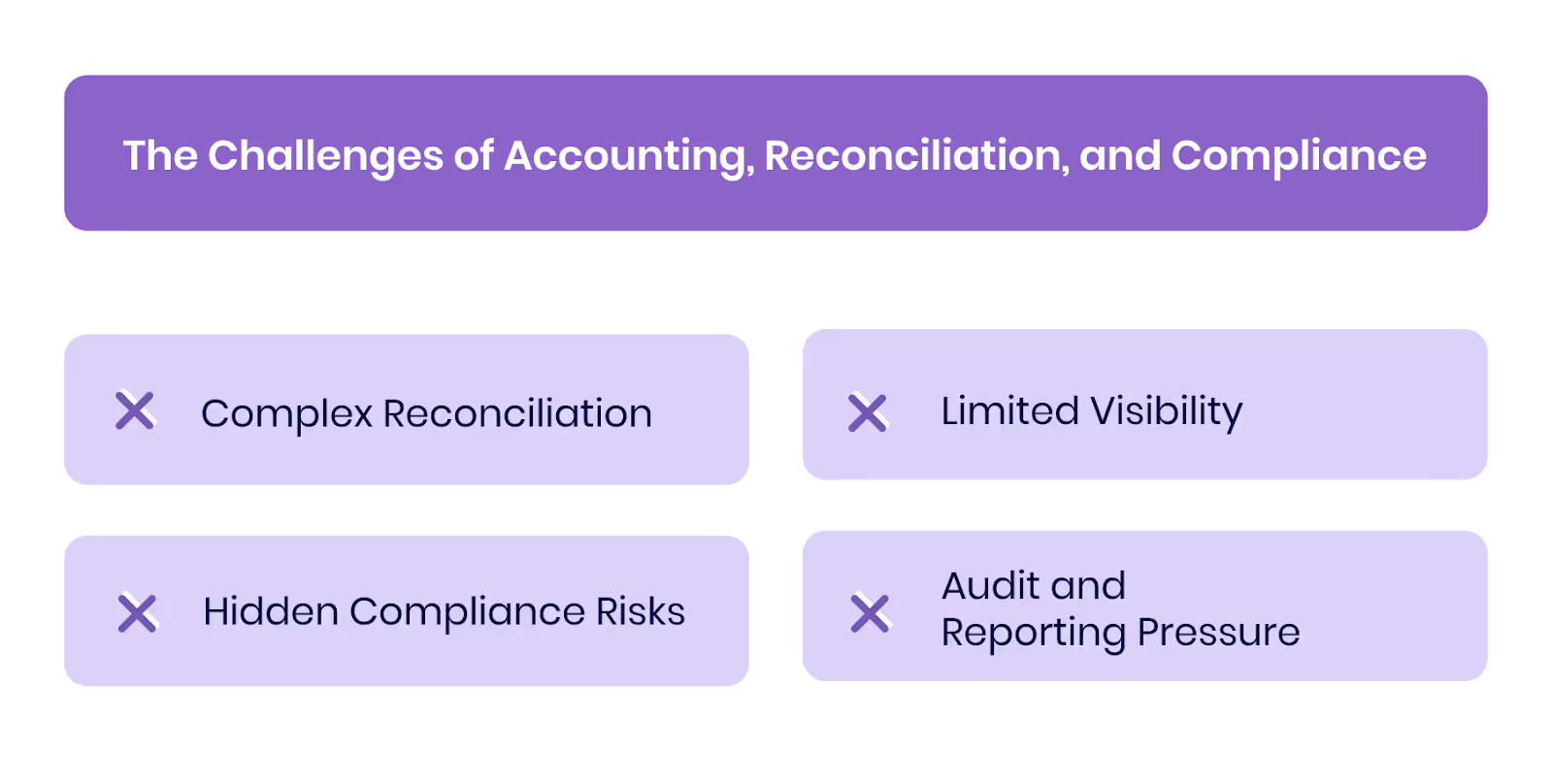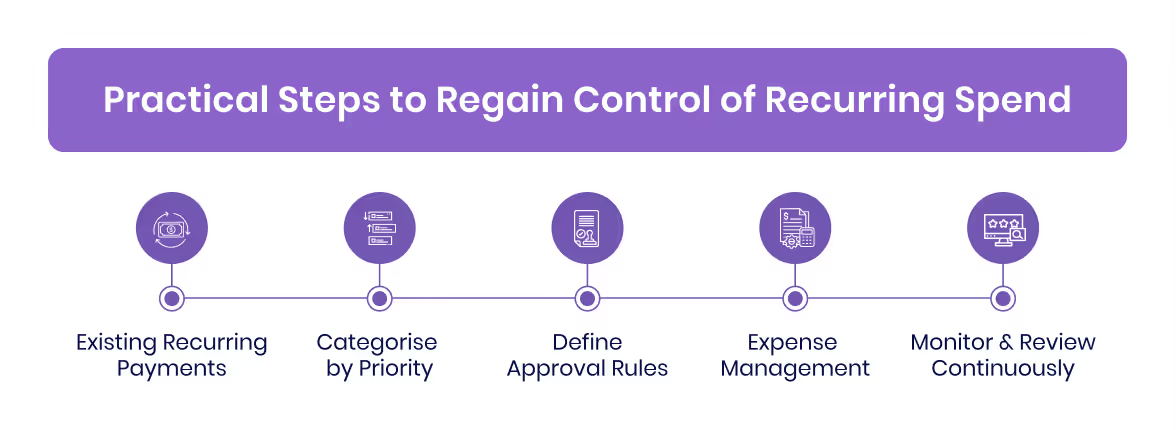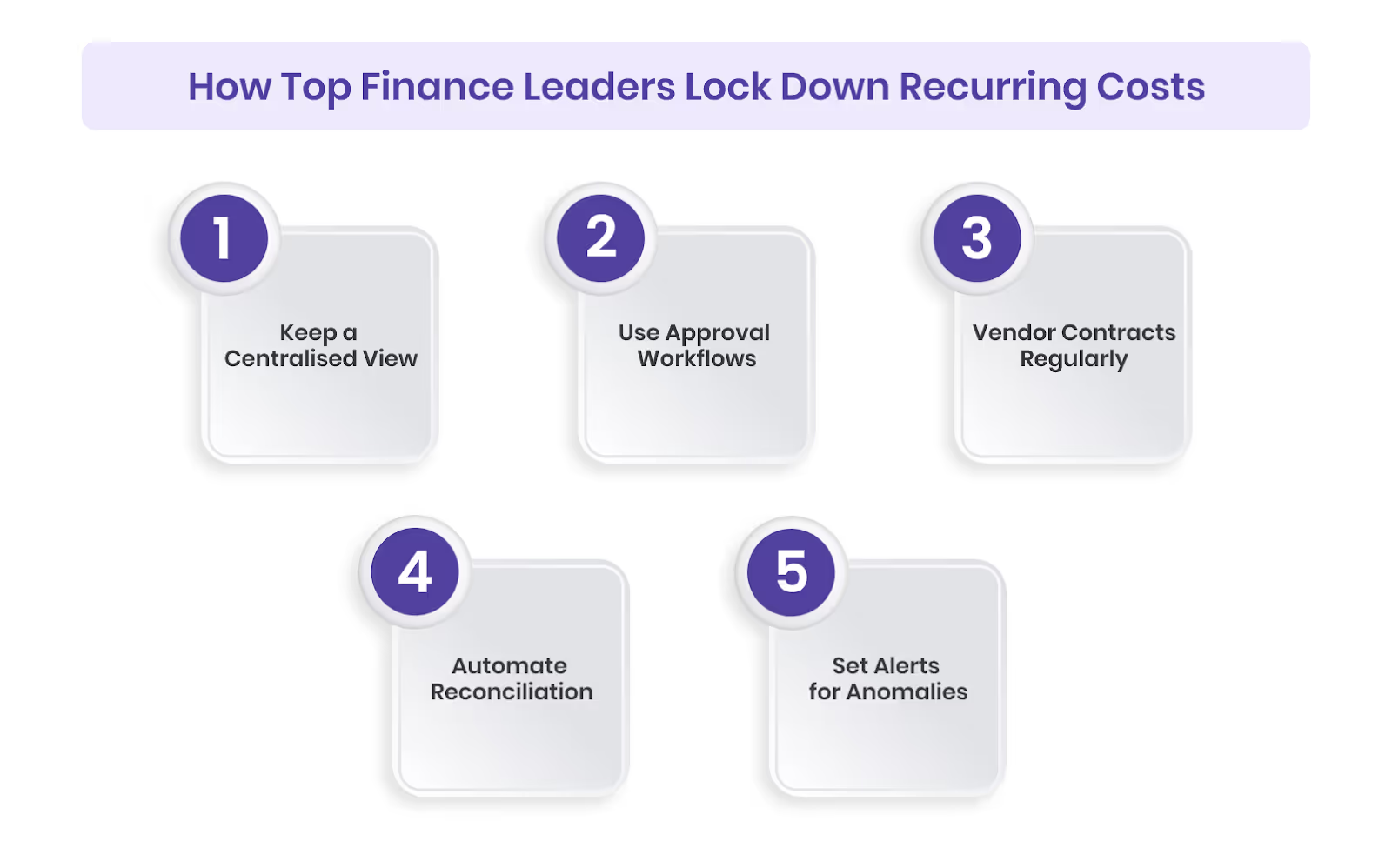A Nexthink study found that employees never use 49.96% of installed software licences. For CFOs, procurement heads, and finance teams, recurring vendor payments such as SaaS, cloud hosting, and platform licences often slip under the radar. They are processed month after month as routine overhead, but without proper oversight, they result in surprise renewals, billing errors, missed VAT claims, and wasted spending.
What appears to be predictable expenditure can quickly erode cash flow, weaken compliance, and reduce financial flexibility. Leaders who lack visibility into these obligations risk locking capital in unused tools, losing audit readiness, and limiting their ability to reallocate resources for growth.
This article explains the meaning of recurring payments, the risks of leaving them unmanaged, and the strategies you can adopt to take back control, improve cash flow, and prevent hidden costs from undermining your business.
Key Takeaways
- How Recurring Payments Work- Recurring charges, whether fixed, variable, or hybrid, create convenience but also blind spots. Without oversight, renewals run on autopilot and vendors may increase costs unnoticed.
- Benefits of Recurring Payments- When managed strategically, recurring payments provide continuity of service, predictable spend, and stronger vendor relationships while reducing admin workload.
- Challenges for Finance Teams- Recurring charges complicate reconciliation, carry VAT compliance risks in markets like the UAE and KSA, and create audit stress when records are fragmented.
- Best Practices to Manage Recurring Spend- Centralise all subscriptions, apply approval workflows, review contracts regularly, automate reconciliation, and set alerts for anomalies.
- Steps to Strengthen Recurring Payment Management- Audit existing recurring spend, categorise by priority, enforce approval rules, integrate with expense management systems, and monitor continuously with alerts and reviews.
Why Recurring Obligations Matter in Corporate Spend
Recurring payments go far beyond customer subscriptions or streaming services. Inside companies, they often take the form of SaaS licences, cloud hosting, professional retainers, or regular supplier charges. These obligations are predictable on paper, but in practice, they can slip under the radar.
The impact is twofold.
- First, they accumulate silently: a small tool added for one team becomes dozens of auto-renewing contracts across departments.
- Second, they reduce financial flexibility. When a large portion of spend is locked into recurring charges, budgets become harder to adjust, and cash flow forecasting turns into guesswork.
The real challenge is not the payments themselves, but the lack of visibility around them. Without clear tracking, companies risk duplicate subscriptions, missed cancellations, or rising vendor fees that go unnoticed until the year-end review. What begins as convenience can quickly erode financial control.
To understand why these issues arise, it helps to look at how recurring payments actually work and the different forms they can take.
How Recurring Charges Flow Through Your Finance Stack
Recurring payments are transactions that repeat automatically at set intervals, most often monthly, quarterly, or annually. Within businesses, they usually cover essentials such as SaaS tools, cloud hosting, software licences, or vendor retainers. Instead of approving every invoice manually, payments are charged to a saved method, and the service continues without interruption.
There are three common forms:
- Fixed charges: These are set fees for each billing period, such as a flat monthly subscription.
- Variable charges: costs that change with usage, such as cloud services.
- Hybrid charges: a mix of fixed fees with add-ons or metered usage.
While automation reduces administrative effort, it can also create financial blind spots. Once renewals run on autopilot, underused or duplicate subscriptions may continue unchecked, and vendors can increase prices without immediate detection.
Recurring Payments as Silent Budget Leaks
Consider a mid-sized technology company in the UAE that recently expanded into Abu Dhabi and the Northern Emirates. Its product and analytics teams frequently launched new cloud environments and SaaS tools as projects grew. Finance budgeted roughly AED 400,000 per month for combined SaaS and cloud services.
One quarter, the bill arrived at AED 1,050,000 — more than double the forecast. The CFO was blindsided.
Root causes:
- Compute clusters were left active after projects ended.
- An API vendor’s hybrid pricing model triggered high overage charges.
- No alerts or spend limits were configured, so overruns went unnoticed.
- Several SaaS upgrades were processed mid-cycle without financial review.
Corrective actions:
- Finance paused non-critical projects and tightened budget controls.
- A usage audit identified idle resources and reclaimed capacity.
- Vendor terms were renegotiated with usage caps and discount tiers.
- Monthly usage reviews and automated overage alerts were introduced, with product and engineering teams held accountable for spend.
This example underscores how variable and hybrid recurring payments, when unmanaged, can quickly overshadow fixed costs and destabilize cash planning. In a regulatory and multi-entity environment, such lapses can have both financial and reputational consequences.
Suggested Read: Cash Flow Optimisation Strategies for UAE Businesses in 2025
The Key Advantages of Managing Recurring Payments Well

Recurring payments are often seen as an operational convenience, but when managed strategically, they can directly support growth and financial efficiency.
1. Continuity of Service
Essential tools and services remain available without disruption. Teams avoid downtime caused by late invoices or missed approvals, which means business operations run smoothly and without unnecessary delays.
2. Reduced Administrative Workload
Instead of teams processing the same invoice month after month, recurring charges are automated. This frees up time to focus on higher-value activities such as financial planning, analysis, or vendor negotiations.
With automated expense management platforms, recurring charges are instantly recorded and matched with digital receipts, eliminating nearly all manual entry.
3. Predictable Spending Patterns
Fixed or semi-fixed recurring costs make it easier to forecast budgets and manage cash flow.
When routed through corporate cards with central dashboards, every renewal becomes visible in one place, providing leadership with a clear view of long-term commitments.
[cta-1]
4. Stronger Vendor Relationships
Consistent, on-time payments build trust with suppliers and service providers. This reliability can translate into better contract terms, preferential support, and stronger long-term partnerships.
5. Scalability for Growing Teams
As businesses expand, recurring payments allow new teams or departments to access services quickly without lengthy procurement cycles. With card controls and approval rules, finance teams can enable this flexibility while still keeping spend under control.
While these benefits are clear, it helps to understand specific accounting and compliance challenges that recurring payments bring.
The Challenges of Accounting, Reconciliation, and Compliance

Recurring payments may seem routine, but without proper oversight they can create hidden risks; unnoticed renewals, missed VAT claims, and hours of manual reconciliation. Predictable spending can quickly become a blind spot, undermining cash flow control and compliance confidence.
Here are the key challenges to be aware of:
1. Complex Reconciliation
Recurring charges hit accounts automatically, but reconciling them in the ERP is rarely seamless. The same vendor may appear multiple times across departments, invoices may arrive late, or charges may not match internal records. Without automation, teams spend hours manually matching payments to cost centres and verifying details.
2. Hidden Compliance Risks
In regions where VAT applies, such as the UAE, recurring vendor charges must meet strict requirements: a valid tax invoice, accurate TRN, and proper categorisation. If invoices are missing or incorrect, companies risk losing VAT claims or triggering audit queries. Recurring charges that renew quietly in the background are especially prone to this oversight.
3. Limited Visibility
Recurring spend is often fragmented across multiple cards or bank accounts. Different teams may set up their own subscriptions, leaving finance with little visibility until charges appear on statements. This not only clouds cash flow forecasting but also increases the risk of duplicate or unused services slipping through unnoticed.
4. Audit and Reporting Pressure
When auditors request evidence of recurring vendor payments, they need invoices, approvals, and payment trails. If records are scattered or incomplete, it extends audit timelines and creates unnecessary stress.
How should businesses manage these obligations effectively and ensure recurring spending works in their favour?
Suggested Read: Who really owns spend in your company?
Practical Steps to Regain Control of Recurring Spend

Turning recurring spend from a risk into a controlled process requires a structured approach. Here are five steps businesses can take to strengthen their management of recurring obligations:
Step 1: Audit Existing Recurring Payments
Start by building a complete list of every recurring charge, including SaaS tools, cloud services, professional retainers, and licences. This baseline will reveal duplicate services, unused subscriptions, and unexpected commitments.
Step 2: Categorise by Priority And Risk
Group recurring payments into categories such as critical, optional, or redundant. This helps determine which commitments should be protected, which can be renegotiated, and which may be cancelled.
Step 3: Define Approval Rules
Before new recurring charges are set up, ensure they follow clear approval workflows. This prevents unplanned commitments from slipping through and keeps budgets aligned with business priorities.
[cta-3]
Step 4: Integrate with Expense Management Systems
Automation is most effective when recurring payments flow directly into expense management and accounting platforms. This enables real-time reconciliation, compliance checks, and role-based visibility.
Step 5: Monitor and Review Continuously
Set up periodic reviews and automated alerts. Regular checks keep vendor costs under control, ensure contracts remain relevant, and highlight opportunities to reduce waste.
Once your organisation has restored visibility and basic control, the next stage is building resilience, turning these steps into a system of leadership-driven discipline that top finance teams rely on to stay ahead.
[cta-4]
How Top Finance Leaders Lock Down Recurring Costs
By applying structured controls such as centralised visibility, approval workflows, automated reconciliation, and anomaly alerts, CFOs and controllers can cut waste, stay compliant, and keep cash flow predictable.

1. Keep a Centralised View of all Subscriptions
Maintain a single register of every recurring payment, from SaaS tools to professional retainers. This prevents duplicate purchases across departments and helps see the full picture of vendor commitments.
2. Use Approval Workflows for New Recurring Charges
Not every service should be allowed to renew automatically. Setting up approval rules ensures that recurring payments are aligned with budgets and priorities before they start.
3. Review Vendor Contracts Regularly
Recurring spend tends to hide in plain sight. Periodic reviews uncover unused licences, duplicate tools, or contract terms that can be renegotiated. This creates room for savings and tighter vendor management.
4. Automate Reconciliation Wherever Possible
Manual matching of invoices to transactions drains teams. Automating this process reduces errors, ensures VAT compliance, and keeps books up to date without last-minute month-end pressure.
5. Set Alerts for Anomalies
Unexpected changes in recurring spend, such as sudden price increases, duplicate charges, or missing invoices, should trigger alerts. Early detection prevents small issues from escalating into budget overruns or audit risks.
With these best practices in place, the real power comes from pairing process discipline with the right tool, one that enforces your rules, surfaces anomalies, and streamlines recurring payments end-to-end.
Manage Recurring Spend Efficiently with Alaan
Recurring vendor payments don’t have to drain budgets or create compliance risks. At Alaan, we make them predictable and controlled:
- Smart corporate cards: Assign every subscription to a central card with spend limits, vendor locks, and instant blocking for unwanted renewals.
- Accounting automation: Match invoices to transactions in real time, flag duplicates or anomalies, and keep every charge VAT-compliant.
- Unified visibility: Track all subscriptions, renewal dates, and vendor costs in a single dashboard, no more fragmented spreadsheets or missed invoices.
The result: predictable and transparent recurring spend, VAT-compliant from day one, with no wasted licences or missed renewals.
Conclusion
Recurring payments can be a hidden drain on time and money when left on autopilot; missed invoices, duplicate charges, and compliance gaps add up quickly. But when managed strategically, they can provide predictable costs, smooth operations, and stronger vendor control.
Imagine a setup where every recurring charge is visible in real time, reconciled automatically, and VAT-compliant from day one. No more chasing receipts, no more surprises at renewal, and no more wasted hours in month-end close.
At Alaan, we make this possible. With our corporate cards and AI-powered expense management platform, businesses gain full control over recurring vendor payments, from automated receipt matching to seamless ERP integration. The result is simple: more time saved, more accurate books, and more confidence in every financial decision.
Schedule a free demo to see how Alaan can help your team take control of recurring spend.
Frequently Asked Questions
1. How do recurring payments affect cash flow?
They create predictable outflows, which can make cash flow easier to forecast. However, if left unmanaged, they can also lock up budgets in unused or duplicate services, reducing flexibility.
2. Are recurring payments VAT-compliant in the UAE and KSA?
Yes, provided vendors issue VAT-compliant invoices with the correct TRN and tax details. Without these, businesses risk losing VAT claims during audits. Automated checks can help flag missing or incorrect invoices.
3. What are the risks of recurring vendor payments?
Risks include duplicate subscriptions, unnoticed price increases, expired but still-billed services, and non-compliant invoices. These can add unnecessary costs and create audit complications.
4. How can companies control recurring payments effectively?
Best practices include maintaining a central register of subscriptions, applying approval workflows, automating reconciliation through an expense management system, and reviewing vendor contracts regularly.


.avif)







